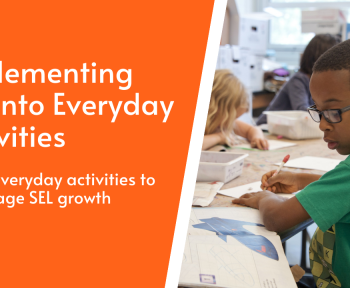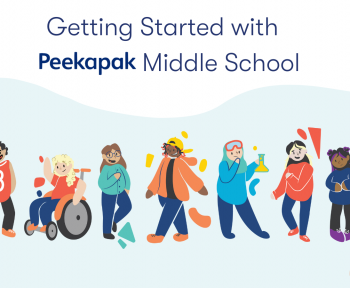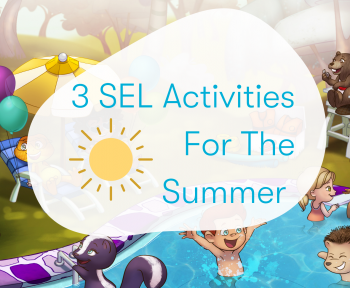Through Peekapak’s Feelings Check-in Tool, teachers are provided with a Mood Board of student sentiment data allowing them to gain insight into their students’ well-being. Such a tool is powerful, especially during these times when students are likely to experience many new changes and unprecedented challenges. In order to provide guidance to our teachers, we have created a “how-to” on implementing, responding to, and supporting this data. Please note, this tool is available for our Classroom PRO and PRO trial users only.
Implementing the Feelings Check-in Tool

First, explain to your students that when they log-in to myPeekaville, they will be prompted to check-in with how they are feeling. The first time a student uses myPeekaville, they will be asked to name how you are feeling and there will be a 10-second countdown. Instruct students to use this time to take deep breaths, close their eyes, and think about how their mind and body feel. Some strategies that you can follow to do this are:
- Reassuring students. “We feel a lot of different feelings throughout the day. You could be excited to go to school, nervous for reading class, angry that you didn’t get picked for the science experiment, calm during math class and so much more! That is all okay! It’s important to name our feelings to help us get back to calm.”
- Modeling for students how to name their feelings by also closing your eyes and taking a deep breath.
- Encouraging students to try this together. “Close your eyes and I am going to count to ten. I want you to take 5 slow breaths during that time and think about how you are feeling. 10, 9, 8, 7, 6, 5, 4, 3, 2, 1 … think of a word in your head that describes how you feel.”
On the screen, there will be different feelings that students can choose from. We advise you to go through each feeling with students so they understand it, and emphasize that it is important to take their time and answer honestly. Every time a student logs-in to myPeekaville, they will complete a Feelings Check-in, which will generate the data provided on your mood dashboard.
Responding to and Supporting the Feelings Check-in Data
You can use the Mood Board to see trends with student feelings in your classroom and for individual students. You can find this dashboard under “Reports” and “Moodboard” under your teacher settings.

These trends will help you gauge your class’ wellbeing and also provide an opportunity for you to guide your students through different calming strategies that tie in directly with our self-regulation unit.
Self-regulation is a skill that helps students manage their behaviors and express emotions in constructive ways. This happens when students are aware of their feelings, able to articulate them (e.g., “I am feeling sad because…”), and can make decisions about how to respond to stimulation. Most importantly, naming our feelings is crucial to self-regulation as it is the first step in helping students reach a calm state that is optimal for learning (Shanker, S. (2012). Calm, alert and happy. Retrieved August 19, 2015.).
On their own, students can explore some of these calming strategies through:
- myPeekaville games related to the Self-Regulation unit;
- Through our lessons, you can guide them through these strategies (“Take a Deep Breath”, “Feelings Dance”, “Is this a calm body?”) and;
- The context of the story “The Peekapak Pals and the Classroom Chaos”.
Some other strategies that you can try to help bring your students back to calm are:
- Guiding angry students through a breathing exercise “take a few deep breaths to pause and reflect”
- If a student likes to write, suggest them to reflect on their feelings and write about them in a journal
- Ask your student to close their eyes and visualize a happy or relaxing place. Have them name the sensory details related to this place, like what they see, what they hear, what they can touch, and what they smell in this place.
- Do a little shake! Having your students jump in place 10 times, jog in place, roar (if appropriate), or just wiggle can help release any excess energy and release feel-good endorphins.
- Help your students change their negative thoughts into positive thoughts. Brainstorm together encouraging and empowering statements they can use as positive self-talk (this is also explored in our optimism unit!).
- Be a role model for your students. Your students will mimic how you cope with stress and so the next time you’re feeling overwhelmed, use that as an opportunity to demonstrate positive self-talk.
More Resources
If you would like to learn more about social-emotional learning, self-regulation, and how to support students through their learning journeys, check out these short, but helpful videos:
- Understanding Our Emotional Health | NowThis Kids
- Teaching Self-Regulation by Modeling | Edutopia
- Motivation, self-regulation and learning how to learn | Heidi Ashton
- Check-In / Check-Out: Providing a Daily Support System for Students
- CAN YOU “NAME THAT EMOTION”? | Lessons for SEL
Thank you for reading our article! We hope you have found our “how-to” guide and Feelings Check-in Tool helpful in supporting your student’s development of their self-regulation skills. If you have any questions or want to contribute your own tip or tool, feel free to share it with us at hello@peekapak.com and we’ll add it to our list!
About Peekapak

Peekapak is committed to helping children become successful, compassionate, caring, and empathetic citizens of the world! How? By teaching children important social-emotional learning (SEL) skills so that topics like gratitude, perseverance, and respect become not just something they hear about, but a part of who they are.
We strive to accomplish this by creating a company and a curriculum that makes SEL fun, easy and seamless for teachers, parents and especially children, so that kids learn without even realizing it. Peekapak’s learning platform can be implemented in person, online or in hybrid teaching models, providing flexible solutions for all school districts.


 How to Articles
How to Articles


